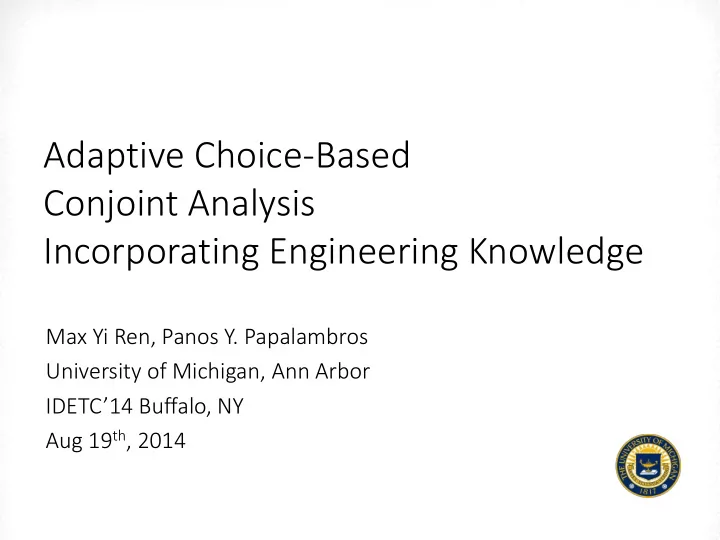

Adaptive Choice-Based Conjoint Analysis Incorporating Engineering Knowledge Max Yi Ren, Panos Y. Papalambros University of Michigan, Ann Arbor IDETC’14 Buffalo, NY Aug 19 th , 2014
Motivation (1/2) partworth Engineering Survey or & cost model Preference model market data Optimal design: Conditional 1 Design w/ the highest prob. 3 probabilities to be to be the most profitable. 2 the most profitable Objective from marketing perspective: Improve the hit-rate of the preference model to help design optimization. 2
Motivation (2/2) Consider optimizing the profit of a USB drive w.r.t. memory capacity $200 Cost $40 $16 $6 $5 $5 (Example modified from E. Feit Dissertation) 8G 16G 32G 64G 128G 256G “8G” is never optimal if larger memory is more preferred. No need to measure the partworth on the level “8G”. Probability of “256G” to be the optimal is low due to high cost. 3
Outline Overview : Optimization by asking good questions Intuition : Preference modeling vs. design optimization Algorithm : Group Generalized Binary Search Case study Conclusion 4
Overview Partworth distribution Deterministic Queries engineering & (pairwise Preference model cost model choices) Optimal design: Conditional 1 One w/ the highest prob. 3 probabilities to be to be the most profitable, 2 the most profitable within a finite set . Objective : To find the optimal design w/ the least number of queries 5
Intuition User feedback to a query is a cut in the version space (the space of feasible partworth). The difference b/w preference modeling and design optimization: 6
Group Generalized Binary Search (1/3) Originally proposed in: Bellala et al., 2012. “ Group based active query selection for rapid diagnosis in time critical situations ”. IEEE Transactions on Information Theory, 58(1), pp. 459 – 478. Internal node : Contains the Leaf node : Contains the final constrained version space, and constrained version space the design most probable to be reaching the node, the current the most profitable. query and response. A sequence of queries forms a path . Ideally, it terminates when the optimal design is derived. A query strategy determines which query to make under user feedback to previous queries. 7
Group Generalized Binary Search (2/3) The partworths of the user is a random vector following an unknown distribution. A prior distribution is assumed . Each query strategy leads to an expected path length , which could be minimized by the best strategy. 8
Group Generalized Binary Search (3/3) The GGBS algorithm finds the best question to ask, based on current and previous users’ responses The algorithm minimizes at each node : Probability mass from Most uncertain D1 the same design into the question same child node D2 MCMC used for calculating conditional probabilities. 9
Case Study: Dial-readout Scale Design 2455 feasible designs on 6 attributes w/ 5 levels. Data and model from Michalek, Feinberg, Papalambros, 2005. 10
Case Study: Settings & Assumptions The true partworths are used to simulate responses. Responses have no random error. Engineering models are deterministic. The best query is picked from four candidates w/ the highest conditional probabilities to be the optimal. GGBS is compared w/ uncertainty sampling (utility balance). 20 independent simulations, each with 50 queries. 11
Case Study: Convergence Result Average #query to find the correct best two designs derived from full knowledge 27 34 Proposed GGBS Variance from MCMC Utility balance Sampling size = 1e5 Most probable vs. current chosen 12
Case Study: Correlation Correlation btw. Estimated partworths and the truth: Proposed GGBS Utility balance Most probable vs. current chosen 13
Future Work Update of conditional probabilities Queries Prior distribution Posterior distribution HB Model Query w/ more than two designs GGBS with noisy user choices 14
Conclusions Key points : The query strategy for finding the optimal design can be enhanced by engineering knowledge. Contribution : Adaptive query is achieve by greedily minimizing the expected path length through GGBS. Major limitation : Real-time interaction is limited to ~1000 candidate designs due to high computation time of MCMC. 15
Acknowledgement NSF CMMI-1266184 Dr. Fred Feinberg, B.School, Univ. of Michigan Dr. Clayton Scott, EE, Univ. of Michigan All my reviewers 16
Thank you What questions do you have? 17
Recommend
More recommend